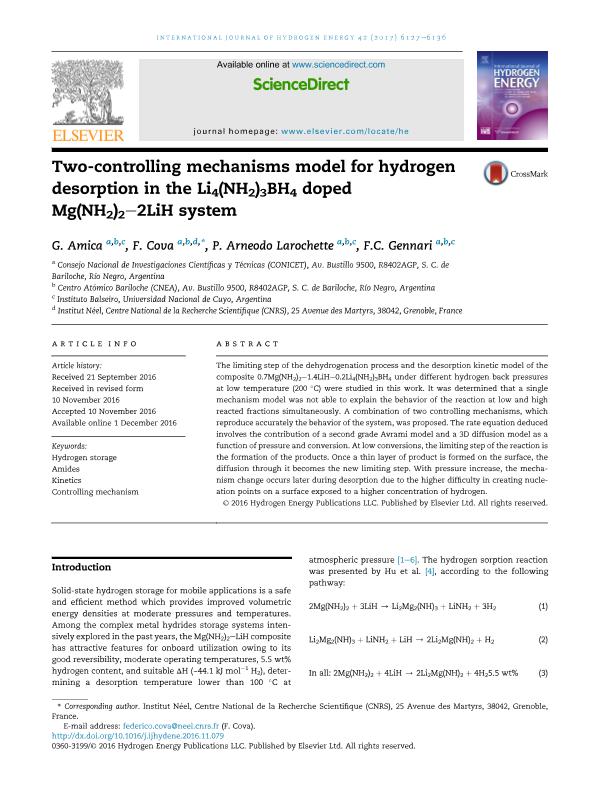Mostrar el registro sencillo del ítem
dc.contributor.author
Amica, Guillermina

dc.contributor.author
Cova, Federico Hector

dc.contributor.author
Arneodo Larochette, Pierre Paul

dc.contributor.author
Gennari, Fabiana Cristina

dc.date.available
2018-09-04T15:43:23Z
dc.date.issued
2017-03
dc.identifier.citation
Amica, Guillermina; Cova, Federico Hector; Arneodo Larochette, Pierre Paul; Gennari, Fabiana Cristina; Two-controlling mechanisms model for hydrogen desorption in the Li4(NH2)3BH4 doped Mg(NH2)2–2LiH system; Pergamon-Elsevier Science Ltd; International Journal of Hydrogen Energy; 42; 9; 3-2017; 6127-6136
dc.identifier.issn
0360-3199
dc.identifier.uri
http://hdl.handle.net/11336/58227
dc.description.abstract
The limiting step of the dehydrogenation process and the desorption kinetic model of the composite 0.7Mg(NH2)2–1.4LiH–0.2Li4(NH2)3BH4 under different hydrogen back pressures at low temperature (200 °C) were studied in this work. It was determined that a single mechanism model was not able to explain the behavior of the reaction at low and high reacted fractions simultaneously. A combination of two controlling mechanisms, which reproduce accurately the behavior of the system, was proposed. The rate equation deduced involves the contribution of a second grade Avrami model and a 3D diffusion model as a function of pressure and conversion. At low conversions, the limiting step of the reaction is the formation of the products. Once a thin layer of product is formed on the surface, the diffusion through it becomes the new limiting step. With pressure increase, the mechanism change occurs later during desorption due to the higher difficulty in creating nucleation points on a surface exposed to a higher concentration of hydrogen.
dc.format
application/pdf
dc.language.iso
eng
dc.publisher
Pergamon-Elsevier Science Ltd

dc.rights
info:eu-repo/semantics/openAccess
dc.rights.uri
https://creativecommons.org/licenses/by-nc-nd/2.5/ar/
dc.subject
Amides
dc.subject
Controlling Mechanism
dc.subject
Hydrogen Storage
dc.subject
Kinetics
dc.subject.classification
Física Atómica, Molecular y Química

dc.subject.classification
Ciencias Físicas

dc.subject.classification
CIENCIAS NATURALES Y EXACTAS

dc.title
Two-controlling mechanisms model for hydrogen desorption in the Li4(NH2)3BH4 doped Mg(NH2)2–2LiH system
dc.type
info:eu-repo/semantics/article
dc.type
info:ar-repo/semantics/artículo
dc.type
info:eu-repo/semantics/publishedVersion
dc.date.updated
2018-09-03T20:03:27Z
dc.journal.volume
42
dc.journal.number
9
dc.journal.pagination
6127-6136
dc.journal.pais
Estados Unidos

dc.description.fil
Fil: Amica, Guillermina. Comisión Nacional de Energía Atómica. Centro Atómico Bariloche; Argentina. Comisión Nacional de Energía Atómica. Gerencia del Área de Energía Nuclear. Instituto Balseiro; Argentina. Consejo Nacional de Investigaciones Científicas y Técnicas; Argentina
dc.description.fil
Fil: Cova, Federico Hector. Comisión Nacional de Energía Atómica. Centro Atómico Bariloche; Argentina. Centre National de la Recherche Scientifique. Institut Néel; Francia. Consejo Nacional de Investigaciones Científicas y Técnicas; Argentina
dc.description.fil
Fil: Arneodo Larochette, Pierre Paul. Comisión Nacional de Energía Atómica. Centro Atómico Bariloche; Argentina. Comisión Nacional de Energía Atómica. Gerencia del Área de Energía Nuclear. Instituto Balseiro; Argentina. Consejo Nacional de Investigaciones Científicas y Técnicas; Argentina
dc.description.fil
Fil: Gennari, Fabiana Cristina. Comisión Nacional de Energía Atómica. Centro Atómico Bariloche; Argentina. Comisión Nacional de Energía Atómica. Gerencia del Área de Energía Nuclear. Instituto Balseiro; Argentina. Consejo Nacional de Investigaciones Científicas y Técnicas; Argentina
dc.journal.title
International Journal of Hydrogen Energy

dc.relation.alternativeid
info:eu-repo/semantics/altIdentifier/doi/http://dx.doi.org/10.1016/j.ijhydene.2016.11.079
dc.relation.alternativeid
info:eu-repo/semantics/altIdentifier/url/https://www.sciencedirect.com/science/article/pii/S0360319916333687
Archivos asociados
